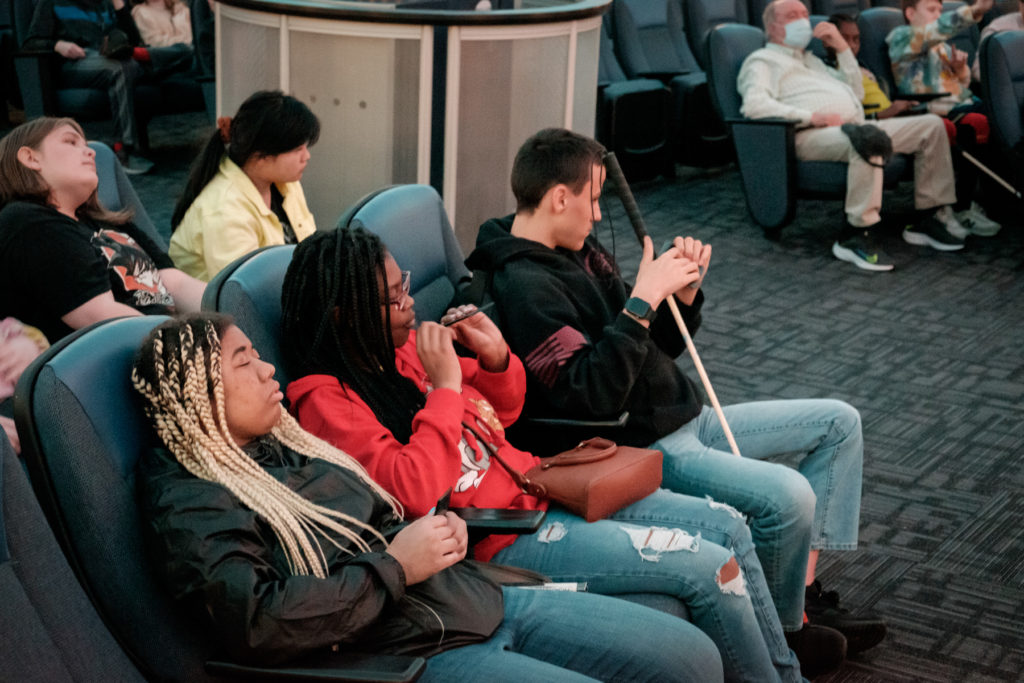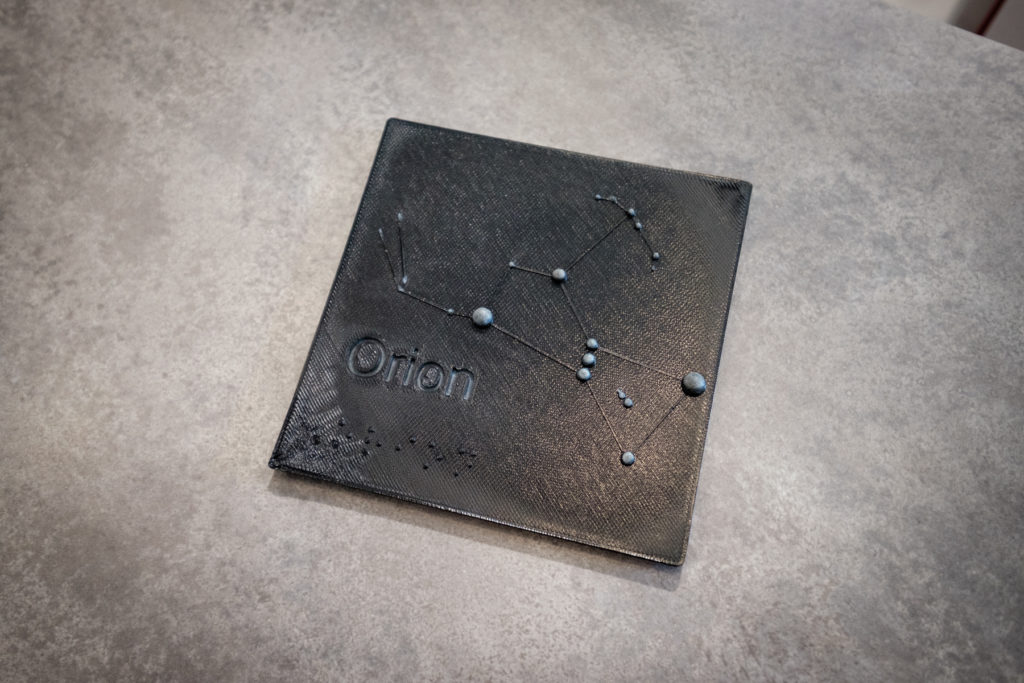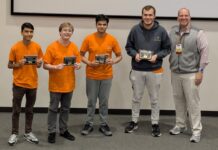A device built by a Mercer University professor will allow students with visual impairments to contribute scientific data to an international program. Physics professor Dr. Matt Marone created the accessible technology — which converts data measurements to speech — for Georgia Academy for the Blind in the spring, and students used it in May to take their first temperature and humidity measurements for NASA’s Global Learning and Observations to Benefit the Environment (GLOBE) Program.
Dr. Marone worked with Georgia Academy for the Blind, in partnership with the Museum of Arts and Sciences, on a few projects in 2022, and Kimberly Novak with the museum approached him this past spring with an idea for another collaboration. The Museum of Arts and Sciences had become a partner and Novak a certified trainer for GLOBE, a program through which citizen scientists across the world make and submit environmental measurements.
Novak wanted to get Georgia Academy for the Blind students involved in GLOBE and asked Dr. Marone if he could create a special device that would allow them to participate.
“The GAB staff is very dedicated, and the students are so open to learning and trying new things given the opportunity. I wanted to help (facilitate) that,” said Novak, former director of outreach programs and services at the museum. “What Dr. Marone did was really creative. He did it on his own time. He’s very kind-hearted.”
The prototype that Dr. Marone built measures temperature and humidity, displaying the data in large font and reading it aloud. He plans to later add instruments to the device for measuring other weather elements, such as rainfall and barometric pressure, and create a case that will protect the sensors. Dr. Marone said a few devices with similar features exist on the market but are expensive, some as much as $3,000. His current device only cost about $140 to build.
“I want to develop this so that it’s kind of like a little weather station sort of thing for the people at the Academy for the Blind to use so that they can then make these measurements and then put them out there on the GLOBE project,” Dr. Marone said.
Novak trained Georgia Academy for the Blind middle school science instructor Cheryl Moore and high school science instructor Dr. Neel Bennett on how to use Dr. Marone’s device and upload data to the GLOBE app. In May, their students took a week’s worth of measurements, Dr. Bennett said. The plan is for students to gather more data during the upcoming academic year.
“They really enjoyed it,” Moore said. “They always enjoy being able to do something that will allow them to be able to operate (equipment) but also do something that a sighted peer would be able to do. With this specific program that Professor Marone did, both Dr. Bennett’s class and mine were basically able to be on even keel with a sighted peer.”


Moore said humidity is a hard concept to explain, and the exercise helped her students better understand the relationship between the data that is presented in numbers and how it feels outside in that moment.
“They thought it was very interesting that even in a few minutes the temperature could go slightly up or down, based on a cloud or a gust of wind,” said Dr. Bennett, a 2006 Mercer graduate.
Georgia Academy for the Blind takes five or six high school students to a weeklong Space Camp in Alabama each year, so students already know a little bit about NASA from that experience. This GLOBE project provides another NASA-sponsored activity for them to get involved in and excited about, Dr. Bennett said.
Marilé Colón Robles, project scientist for NASA GLOBE clouds observations, said she was thrilled to learn about the device that Dr. Marone created. She is part of a GLOBE technology subcommittee dedicated to inclusivity and accessibility, and members are focusing on low-vision and blind students this year and working to find more accessible observation methods. The device addresses a need within the GLOBE program and, if shared and expanded, has the potential to reach people across the world.
“This (device) is extremely exciting,” Colón Robles said. “I can imagine a whole community of just blind students from around the world getting together and using the structure that the GLOBE program provides where you can submit your own research. I can imagine a whole set of new research from these students that we haven’t had before. I’m sure that they’ll notice things that maybe other people that do have sight won’t catch. That’s the beauty of this community, that they learn things differently, and that’s what we need to discover new things or new details in the data.”
Once the prototype becomes a more finished product, Dr. Marone would like to seek funding to produce it at Mercer and send it to GLOBE participants who are visually impaired.
“There are students from all different countries, and you never know how many visually impaired kids could be out there who might want to be involved, but they don’t have the hardware to do it,” Dr. Marone said. “It’s really cool that Mercer gives me the freedom to do these kinds of things. I’m grateful to have that.”

Dr. Marone said an experience 20 years ago sparked his interest in providing more accessible science education for visually impaired students. He was spending a summer working at NASA in Huntsville, Alabama, and helped a friend with a Space Camp presentation for children with disabilities, most of whom were visually impaired. During one demonstration, students learned about meteorites and astrobiology by touching different materials, including an ammonite fossil.
“One girl said to another, ‘Wow, this thing is so beautiful,’ and I’m standing there thinking, ‘How do they know it’s beautiful? They really can’t see it,’” Dr. Marone said. “But what they were responding to was the shape of it, the feeling of it. So that made me start thinking about things related to how blind kids can get involved in science. I could see that they were enthusiastic and interested in it.”
That moment has always stood out in Dr. Marone’s mind, and the connection forged in recent years with the Museum of Arts and Sciences in Macon has allowed him to bring hands-on science experiences to visually impaired children.
Last year, Georgia Academy for the Blind students worked with Novak on a tactile exhibit on the layers of the atmosphere, and Dr. Marone printed some 3D elements for it, Novak said. Then in April 2022, he created and presented a planetarium show for Georgia Academy for the Blind students at the museum. Each student received a 3D-printed card with a model of the Orion constellation.
“We had the lights on low, but then Dr. Marone gave a presentation to the students using those cards. They were able to actually experience a planetarium show in a planetarium. It wasn’t just reading braille in a book,” Novak said. “It was a really wonderful way to have the students do something that they might not have had the opportunity to do before.”
Following that event, Dr. Marone presented the planetarium show a second time at the museum and showcased his 3D constellations as well as 3D math equations during the National Federation of the Blind’s meeting in Pennsylvania.











